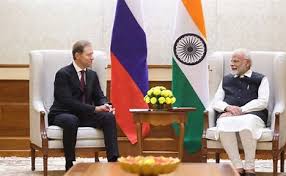Ever since the NDA government came to power, one has heard noises from the opposition parties that all the moves on the economic front by Prime Minister Modi were actually started by the UPA government. True. No big economic ideas can be thought of every day afresh. All the ideas are from the economic textbooks whose roots are in good old ‘Development Economics’ which no one talks about much these days. Hence ideas from Keynes, Kaldor, Kuznets and Rostow have been floating around ever since India’s Independence and the First Five Year Plan.
In 1950, Nehru thought of rapid economic development based on the Soviet model of G.A. Feldman that emphasised the need for capital goods industry. He visualised India’s industrialisation in which India would be able to produce machinery and steel. He did not emphasise on the consumer goods industry and left it to be developed by the private sector. At that time all the newly independent countries were trying to break away from their colonial past of ‘Centre and Periphery’ and wanted to industrialize instead of remaining suppliers of primary goods and raw materials.
Nehru’s protectionist stance sprang from the need to conserve foreign exchange for purchase of important technology to establish our own heavy industries. Many of us grew up with strict import control and had no access to imported consumer goods. Indians shopped abroad even for simple cosmetics and appliances. But the emphasis on heavy industry paid off and today our public sector enterprises are the pride of the country. They are the biggest profit makers and employers of manpower. Of course many of the PSUs became sick over time.
Similarly Nehru’s emphasis on science and technology and the establishment of IITs also paid off very well and today India has the second highest number of engineers and scientists in the world. Many after availing of the high quality education in Indian IITs went abroad and never came back. The result is that in every prestigious university abroad you can find Indians occupying top research and academic positions. The brain drain was a phenomenon of the 1970s and 80s.
Gradually the alternative of export-led growth was visible in the fast emergence of the Newly Industrialized Countries (NICs) of the Far East and influential economists believed that the export led growth model followed by South Korea, Indonesia, Malaysia, Thailand and Philippines was right for India.
The gradual opening up of the economy started during Indira Gandhi’s time. Rajiv Gandhi took the globalisation process further and India gradually became linked with countries abroad through trade and investment. Of course, the biggest breakthrough came under Narasimha Rao’s government when under pressure from the IMF, India had to get rid of the Licence permit raj and agreed to the opening up of the Indian economy.
India did well as long as the global economy was on the rise. Many reforms were initiated by the UPA government and India achieved double digit growth in 2008-09. It brought India in the limelight and it was all set for the ‘take off’ stage as described by W. W. Rostow.
Modi inherited a rather robust economy and he is continuing to undertake economic reforms but the take-off has somehow been stalled because of other big problems that engulf us today and have remained unsolved.
Building of roads, railways, ports and airports though planned on a grand scale was not achieved to tackle the pressures of urbanisation and globalisation. In other words, infrastructure remained inadequate, even primitive, as compared to the needs of an Emerging Market Economy. Corruption and procedural delays along with policy paralysis were responsible for this.
In the area of human development, gross failings stared us in the face. With 48 per cent of the children under 5 years being mal-nourished , India could not call itself an advanced Emerging Market Economy. Also with 90 per cent of the people working in the Informal or organised sector who had no social safety net to fall back upon, the conditions of work/ skills/education of the labour force remained precarious. The health sector remained strapped for funds.
Social security for the poor was talked about in the UPA government but was not implemented on grounds of lack of government funds. When Modi announced the same schemes and with all the allocations firmly in place, the former UPA government took credit for having thought of it! What is important is that Modi government has had the mandate and courage to undertake and endorse the schemes for the poor which in itself is path breaking.
Similarly a single minded leadership is in sight in other social sector schemes like the Jan Dhan Yojana. Of course, the ideas are old because all welfare schemes have been tried elsewhere in the world. But the fact that the Modi government is endorsing and approving such schemes with so much fanfare is something new.
Devolution of power from the Centre to the States is also nothing new and is the basis of federalism. It is true that dismantling the Planning Commission was talked about in the past many times. But the UPA government continued with the Planning Commission perhaps because of the Nehruvian legacy. But now to say that UPA also believed in abolishing planning commission is too late a pronouncement!
May be Mr. Modi as Chief Minister of Gujarat faced many problems in the implementation of his ideas and his firsthand experience was instrumental in his taking the drastic step of doing away with a centralized planning body. He has given more finances (52%) to the States ( 10% more) than before and even though it is not hugely different, it is a symbolic change.
Even Modi’s slogans of Swacch Bharat, Make in India and Digital India are not new. Building toilets in villages has been done before but perhaps not at the scale at which it is being done now. But Modi government has to watch out that though it is being credited with having a strong and determined leader, the expectations are high and all the initiatives will be judged by the people according to the results they yield because everything has been tried before.
(The writer is a Senior Fellow at Observer Research Foundation, Delhi)
Courtesy: ORF– Modi’s reforms agenda: Implementation is the key
Author Profile
- India Writes Network (www.indiawrites.org) is an emerging think tank and a media-publishing company focused on international affairs & the India Story. Centre for Global India Insights is the research arm of India Writes Network. To subscribe to India and the World, write to editor@indiawrites.org. A venture of TGII Media Private Limited, a leading media, publishing and consultancy company, IWN has carved a niche for balanced and exhaustive reporting and analysis of international affairs. Eminent personalities, politicians, diplomats, authors, strategy gurus and news-makers have contributed to India Writes Network, as also “India and the World,” a magazine focused on global affairs.
Latest entries
 DiplomacyOctober 4, 2025UNGA Resolution 2758 Must Not Be Distorted, One-China Principle Brooks No Challenge
DiplomacyOctober 4, 2025UNGA Resolution 2758 Must Not Be Distorted, One-China Principle Brooks No Challenge India and the WorldJuly 26, 2025MPs, diplomats laud Operation Sindoor, call for national unity to combat Pakistan-sponsored terror
India and the WorldJuly 26, 2025MPs, diplomats laud Operation Sindoor, call for national unity to combat Pakistan-sponsored terror India and the WorldJuly 25, 2025When Fire Ends, Diplomacy Begins
India and the WorldJuly 25, 2025When Fire Ends, Diplomacy Begins India and the WorldJuly 16, 2025Operation Sindoor and its Aftermath: India’s Successful Diplomatic Outreach
India and the WorldJuly 16, 2025Operation Sindoor and its Aftermath: India’s Successful Diplomatic Outreach








